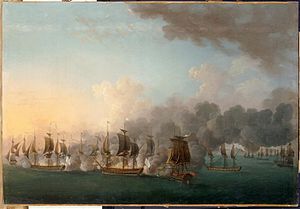- Action of 21 July 1781
-
"Naval battle off Louisbourg" redirects here. For the siege during the War of the Austrian Succession (King George's War), see Siege of Louisbourg (1745). For the 1758 siege during the French and Indian War, see Siege of Louisbourg (1758).
Battle off Spanish River
Combat naval en vue de LouisbourgPart of the American Revolutionary War 
Naval battle off Cape Breton (Combat Naval A La Hauteur De Louisbourg) by Auguste-Louis de Rossel de CercyDate July 21, 1781 Location Off present-day Sydney, Nova Scotia Result Tactical French victory; strategically inconsequential Belligerents  France
France Great Britain
Great BritainCommanders and leaders  Latouche Tréville
Latouche Tréville
 La Pérouse
La Pérouse Captain Evans †
Captain Evans †
 Captain George
Captain GeorgeStrength 2 frigates:
Astrée (38)
Hermione (34)6 warships:
Charlestown (28)
Allegiance (24)
Vernon (24)
Vulture (20)
Jack (14)
Thompson (18) (did not fight)
9 coal transports
4 supply shipsCasualties and losses 6 killed
34 wounded~17 killed
48 wounded
2 warships and 3 merchantmen captured- 1st Machias
- Gloucester
- Falmouth
- Block Island
- Fort Cumberland
- Ridgefield
- Sag Harbor
- St. John River
- 2nd Machias
- Setauket
- Mount Hope Bay
- Newport
- Grey's raid
- Chestnut Neck
- Little Egg Harbor
- Tryon's raid
- Penobscot Expedition
- Fort St. George
- Cape Breton
- Groton Heights
- Fort Slongo
- Halifax
- Lunenburg
American
Revolutionary War:
North American Waters- 1st Machias
- Gloucester
- Falmouth
- Block Island
- 2nd Machias
- Newport
- Grey's raid
- Chesapeake raid
- Tryon's raid
- Penobscot
- Cape Henry
- Cape Breton
- Capture of USS Trumbull
- 1st Chesapeake Bay
- Capture of HMS Savage
- Delaware Bay
- Halifax
- Lunenburg
- Hudson Bay
- 2nd Chesapeake Bay
The Battle off Spanish River[1] took place during the American Revolution between two French Navy frigates and a convoy of 18 British ships under protection of the Royal Navy off the harbour of Spanish River, Cape Breton, Nova Scotia (present-day Sydney, Nova Scotia). The two French Navy Frigates were led by the famous Admiral Latouche Tréville and La Pérouse, who were outnumbered and still victorious in the battle.
Contents
Historical Context
The attack took place in the context of the Franco-American alliance against Great Britain in the American Revolutionary War.[2][3]
Encounter
The British convoy was bound for Spanish River on Cape Breton Island to pick up coal for delivery to Halifax.[4] It was composed of 18 ships, including 9 coal-transporting ships and 4 supply ships.[5] The escorting ships were the frigate Charlestown (28), two sloops Allegiance (24) and Vulture (20), an armed transport Vernon (14), and another small armed ship Jack (14).[4]
Two French frigates attacked the convoy:[5] they were the Astrée (38), commanded by La Pérouse, and the Hermione (34), commanded by Latouche Tréville. The French ships severely damaged the Charlestown in the encounter, losing her mainmast and much of her command crew, including Captain Evans. The French also significally damaged Jack, which also lost her captain and struck her colors. The engagement ended with the fall of night. Captain George of the British ship Vulture led the damaged escorts into harbor. Six French sailors were killed and 17 British.[6]
While the British escort was severely damaged, the convoy picked up a load of coal at Spanish River and delivered it to Halifax.[4] The French captured the two British ships Jack and Thorn off of Halifax Harbour, along with three merchantmen, and were brought back to Boston. (The following year, the Jack was recaptured by the British in the Naval battle off Halifax.)
Afterwards
The two French commanders would become particularly famous, as Latouche Tréville became an Admiral and a hero of the Napoleonic war, and La Pérouse became a famous explorer. One of the ships, the Hermione, had brought La Fayette to the United States, and a copy is now under construction in the original docks of Rochefort.
Comemmorations
The encounter was painted by Auguste-Louis de Rossel de Cercy, and is on display at the Musée Nationale de la Marine in Rochefort.
Images of the Battle
See also
- Franco-American alliance
Notes
- ^ (French: Combat naval en vue de Louisbourg, or Combat naval à la hauteur de Louisbourg)
- ^ History of the origin, formation, and adoption of the Constitution of the United States George Ticknor Curtis, p.156 [1]
- ^ Brian Douglas Tennyson and Roger Flynn Sarty (2002), Guardian of the Gulf, University of Toronto Press. Pages 18-19
- ^ a b c Frigates and Foremasts: The North American Squadron in Nova Scotia Waters, 1745- 1815 by Julian Gwyn p.72-3[2]
- ^ a b Ashore and afloat by Julian Gwyn p.155 [3]
- ^ http://www.awiatsea.com/incidents/1781-07-21%20Battle%20off%20Spanish%20River.html
References
- Gwyn, Julian, Ashore and afloat
- Gwyn, Julian (2004), Frigates and Foremasts: The North American Squadron in Nova Scotia. Waters, 1745–1815, UBC Press.
- Murdoch, Beamish, A History of Nova-Scotia, or Acadie.
Links
Categories:- Naval battles involving France
- Naval battles involving Great Britain
- Naval battles of the American Revolutionary War
- History of the French Navy
- Conflicts in 1781
- History of Nova Scotia
- Conflicts in Nova Scotia
- Maritime history of Canada
- Conflicts in Canada
Wikimedia Foundation. 2010.




